Week 1: Sun, Earth, and the Moon
Dr. Ted Neal and Alexis Hatvick
Formative Assessment: Sun, Earth, and the Moon
🧠 Big Ideas and Big Questions
- Why do we have seasons?
- Is the Earth or the Sun at the center of the Solar System?
- How do the Sun, Earth, and Moon interact?
- How can the Sun’s position create shadows, eclipses, and equinoxes?
- How do these interactions affect what we see from Earth?
💭 Reflections and Additional Resources
- Formative Assessment: Sun, Earth, and the Moon
- Explore: Where are the Moon, Sun, and Earth compared to each other for the different Moon phases?
📚 Vocabulary
- Heliocentrism: The theory that the Sun is at the center of the solar system.
- Geocentrism: The theory that Earth is at the center of the solar system.
- Equinox: The day when there is an equal amount of day and night (12 hours each).
- Solstice: The day with the most or least sunlight in a year.
- Eclipse: When light from the Sun or Moon is blocked by another object.
Seasons
Earth’s axis is tilted, so different areas are tilted toward the Sun at different times of year, causing seasons.
- If a hemisphere is tilted toward the Sun, it’s summer there.
- If a hemisphere is tilted away, it’s winter.
Earth orbits in the same plane as the other planets in our solar system: the Plane of the Ecliptic. However, Earth is also tilted on its axis. This tilt never changes in relation to space, so different areas of Earth are tilted toward the Sun at different times of year. This is why we have seasons.
- If a hemisphere is tilted towards the Sun, it gets more sunlight and it warms up–aka summer.
- If a hemisphere is tilted away from the Sun, it gets less sunlight and it cools down–aka winter.
Additionally, the Northern and Southern Hemispheres have opposite seasons due to the tilt of Earth’s axis. When the Northern Hemisphere is tilted towards the Sun, it is summer (this is winter in the Southern Hemisphere). When the Southern Hemisphere is tilted towards the Sun, it is summer (this is winter in the Northern Hemisphere).
Earth’s seasons are explained in the image below.
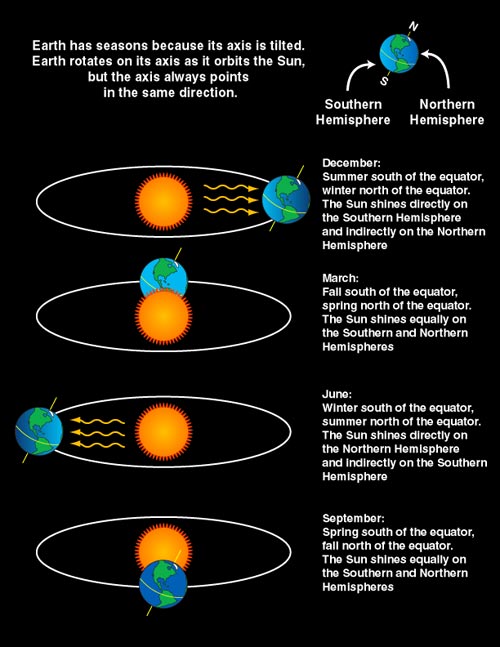
Image: Seasons by NASA Space Place (public domain)
Heliocentrism vs Geocentrism
In early times, humans believed in geocentrism–the theory that Earth is at the center of the solar system, and the Sun and other planets revolved around it. During the Renaissance in the 1500s, Copernicus popularized the concept of heliocentrism–the theory that the Sun is at the center of the universe and Earth orbits the Sun. Galileo’s observations with the telescope disproved the geocentric model, but the Catholic Church resisted this idea for many years.
Throughout Copernicus’s lifetime, the scientific community widely denied the theory of heliocentrism. A generation later, the Sun-centered theory became more commonly accepted when Galileo invented the telescope in 1609, making it easier to observe space. Additionally, Galileo made a variety of discoveries about our solar system that disproved the geocentric model of the universe. Despite these discoveries, however, there was still significant pushback against heliocentrism, particularly from the Catholic Church.
At the time, the Church defended its stance on geocentrism because it believed Galileo’s discoveries left too many questions unanswered and did not explicitly prove heliocentrism. During this period, a case could still technically be made for geocentrism until technology advanced enough for scientists to discover more evidence supporting heliocentrism.
Additionally, the Church had certain clergy who interpreted parts of the Bible very literally, as if it were a science textbook rather than a theological work. Galileo’s claims were scandalous in their eyes because heliocentrism directly conflicted with certain biblical passages. For these reasons, the Church put Galileo on trial, convicted him of heresy, and sentenced him to house arrest for the remainder of his life. In 1822, the Church eventually accepted the theory of heliocentrism once there was enough scientific evidence to claim it as truth. Finally, in 1992, the Catholic Church, after a 13-year investigation by Pope John Paul II, formally acknowledged that Galileo was unfairly prosecuted. LINK
Key Takeaway
To remember the theories of heliocentrism and geocentrism, break down the names and look at the etymology.
- geo = “earth”, centr = “center” → geocentrism: Earth at the center.
- helio = “sun”, centr = “center” → heliocentrism: Sun at the center.
Equinox & Solstice
- Equinoxes (Spring & Autumn): All of Earth receives equal sunlight—12 hours. It occurs when the Equator is directly in line with the Sun (around March 20 and September 23).
- Solstices (Winter & Summer): Mark the shortest and longest days of the year.
- Winter Solstice: Least sunlight (around December 21).
- Summer Solstice: Most sunlight (around June 21).
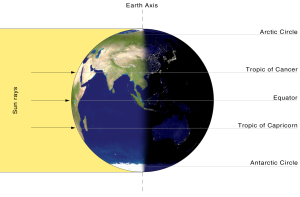
“Illumination of Earth by Sun on the day of equinox” by Przemyslaw “Blueshade” Idzkiewicz is licensed under CC BY SA-2.0
Solstices mark the days of the year in which a hemisphere receives the least amount of sunlight (aka the shortest day of the year) and the most amount of sunlight (aka the longest day of the year). These days occur when one of the tropic lines is directly in line with the Sun. In the Northern Hemisphere, the Winter Solstice (the day with the least sunlight, usually around December 21) occurs when the Tropic of Capricorn (the southern tropic line) is in line with the Sun. The Summer Solstice (the day with the most sunlight, usually around June 21) occurs when the Tropic of Cancer (the northern tropic line) is in line with the Sun.
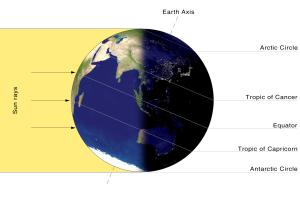
“Illumination of Earth by Sun on the day of summer solstice in the northern hemisphere” by Przemyslaw “Blueshade” Idzkiewicz is licensed under CC BY SA-2.0
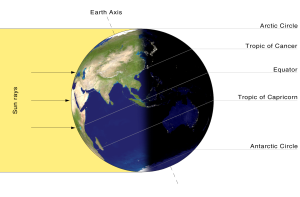
“Illumination of Earth by Sun on the day of summer solstice in the northern hemisphere” by Przemyslaw “Blueshade” Idzkiewicz is licensed under CC BY SA-2.0
Images: Equinox and Solstice by Przemyslaw “Blueshade” Idzkiewicz (CC BY SA-2.0)
Shadows
As Earth orbits the Sun, the length and direction of shadows change.
- During the Summer Solstice in the Southern Hemisphere, if you are standing on the Tropic of Capricorn at noon, your shadow points directly beneath you.
- In Iowa, as we approach the Spring Equinox, shadows become shorter.
Watch the video, below, to learn more about the tropic lines and Earth’s shadows. The following practice questions will be explained in the video:
- It is the Summer Solstice in the Southern Hemisphere, and you are standing on the Tropic of Capricorn. It is noon, so the Sun is directly above you. Which direction does your shadow point?
- If you are in Iowa, what will happen to the length of your shadow as we approach the Spring Equinox?
Eclipses
- Solar Eclipse: The Sun is blocked when the Moon passes between Earth and the Sun (occurs during a new moon).
- Lunar Eclipse: The Moon is blocked when it passes through Earth’s shadow (occurs during a full moon).
Solar Eclipse
- In a solar eclipse, the Sun is blocked–this happens when the Moon perfectly crosses between Earth and the Sun. A solar eclipse always occurs during a new moon.
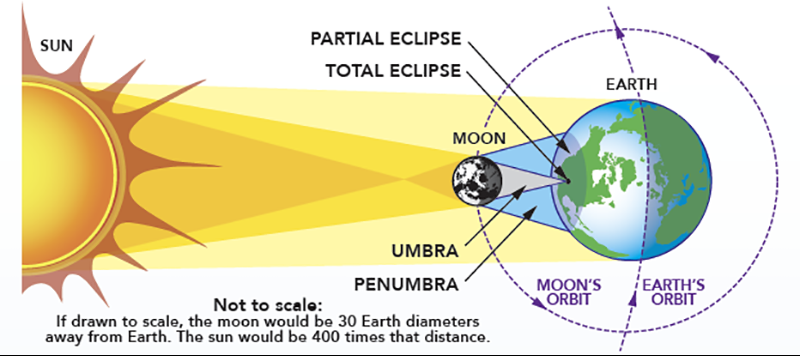
Image credit: “Total Solar Eclipse” by NASA
For more explanation of solar eclipses, watch the video below:
Video credit: “What Creates a Total Solar Eclipse?” by Andy Cohen/TED-Ed is licensed under CC BY-NC-ND 4.0
Lunar Eclipse
- In a lunar eclipse, the Moon is blocked when it passes through Earth’s shadow. When the Moon is in this position, the Sun’s light cannot reach it. A lunar eclipse always occurs during a full moon.
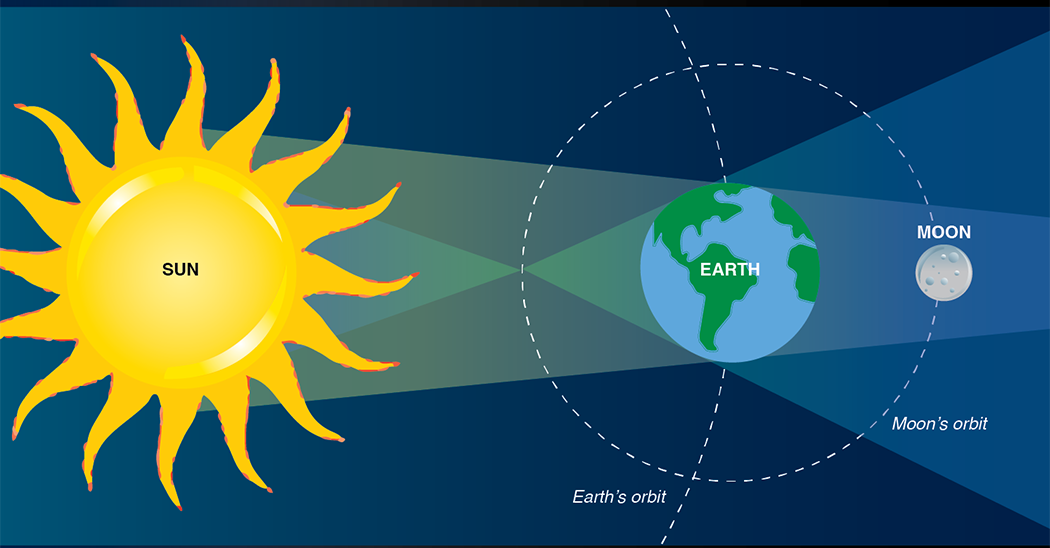
“Lunar Eclipse” by NASA’s Marshall Space Flight Center is licensed under CC BY-NC 2.0
For more explanation of lunar eclipses, watch the video below:
Video credit: “Lunar Eclipse Essentials” by NASA is public domain
Images: Total Solar Eclipse by NASA; Lunar Eclipse by NASA’s Marshall Space Flight Center (CC BY-NC 2.0)Key Takeaways
- As Earth orbits around the Sun, different areas receive direct or indirect sunlight due to the tilt of Earth on its axis. This is what causes seasons.
- Earth’s distance from the Sun does not cause the seasons.
- The tropic lines, equator, and Arctic Circle all mark areas of specific direct sunlight.
👩🏫 Teacher Talk
- This lesson aligns with NGSS 1-ESS1-1: Use observations of the sun, moon, and stars to describe patterns that can be predicted.
- NGSS 1-ESS1-2: Make observations to relate the amount of daylight to the time of year.
- NGSS 5-ESS1-2: Represent data in graphical displays to reveal patterns of daily changes in length and direction of shadows, day and night, and the seasonal appearance of some stars.
📎 Resources
- Moon Phases from Earth (Image)
- The Moon (Khan Academy Video)
- Total Solar Eclipse (NASA)
- Lunar Eclipse (NASA)
- Seasons (NASA Space Place)
Performance Expectations
| 1-ESS1-1 | Use observations of the sun, moon, and stars to describe patterns that can be predicted. |
|---|
| 1-ESS1-2. | Make observations at different times of year to relate the amount of daylight to the time of year. [Clarification Statement: Emphasis is on relative comparisons of the amount of daylight in the winter to the amount in the spring or fall.] [Assessment Boundary: Assessment is limited to relative amounts of daylight, not quantifying the hours or time of daylight.] |
|---|
| 5-ESS1-2. | Represent data in graphical displays to reveal patterns of daily changes in length and direction of shadows, day and night, and the seasonal appearance of some stars in the night sky. [Clarification Statement: Examples of patterns could include the position and motion of Earth with respect to the sun and selected stars that are visible only in particular months.] [Assessment Boundary: Assessment does not include causes of seasons.] |
|---|
| MS-ESS1-1. | Develop and use a model of the Earth-sun-moon system to describe the cyclic patterns of lunar phases, eclipses of the sun and moon, and seasons. [Clarification Statement: Examples of models can be physical, graphical, or conceptual.] |
|---|
Disciplinary Core Ideas: DCI
First grade: ESS1.B: Earth and the Solar System
Fifth grade: ESS1.B: Earth and the Solar System
Middle School
Crosscutting Concepts: CCC
First grade: Patterns
– – – – – – – – – – – – – – – – – – – – – – – – – – – – – – – – – – – –
Connections to Nature of Science
Scientific Knowledge Assumes an Order and Consistency in Natural Systems
- Science assumes natural events happen today as they happened in the past. (1-ESS1-1)
- Many events are repeated. (1-ESS1-1)
Patterns
Cause and Effect
Systems and System Models
Lesson ideas:
- Create a daily journal of sky observations: where the Sun is, what time the Sun rises and sets, and the Moon’s position. Can be part of daily calendaring. Compare to seasons.
- Play with shadows outside and inside: shadow tag, tracing shadows with sidewalk chalk, and seeing how they move throughout the day; compare shadows to where the Sun is. Play with shadows inside: shine flashlights on sticks indoors, have kids move the flashlight up and down to see how the length of the shadow moves. Draw the shadow and write where the flashlight was.
- Experiment with the Sun/Moon/Earth system as we did in class to understand equinoxes, solstices, eclipses, seasons, etc.

